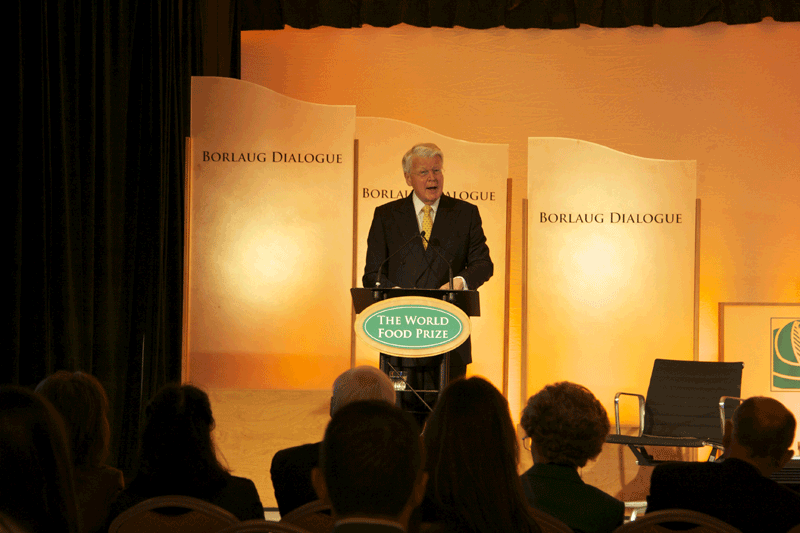Ice, energy, and food
AN UNLIKELY TRIANGLE
“EVERY NATION NOW lives in what I call an ice-dependent world,” says Ólafur Ragnar Grímsson, President of Iceland, “where the mass of the arctic sea ice in my neighborhood causes extreme weather on faraway continents in Asia, Africa, and the Americas – destroying crops and urban infrastructure. But also that the retreat of the glaciers in Greenland and in Antarctica will, through the rising sea levels, threaten every coastal city in America, Asia, and elsewhere.”
PHOTO: ÓLAFUR RAGNAR GRÍMSSON, PRESIDENT OF ICELAND, SPEAKING ON THE CONNECTIONS BETWEEN ICE, ENERGY, AND FOOD AT THE 2013 WORLD FOOD PRIZE EVENT IN DES MOINES, IOWA.

That is how President Grímsson opened his speech on the connections between Ice, Energy, and Food at the 2013 World Food Prize event in Des Moines, Iowa. For too long, he notes, ice has been on the periphery.
“Our weather, our climate, our crops, our cities are dependent in one way or another on what happens to the ice,” he says. “The glaciers are not divorced far away from our fate. They are, indeed, my friends, the core of our future.”
THE THREE POLES
Grímsson argues that there are three “poles” to worry about, not just the obvious two. His list includes the Arctic, Antarctica, and the Himilayas, since the latter, with its thousands of glaciers, harbours water reservoirs for the great rivers of India and China. Glaciologists and members of the Polar Research Institute of China agree. They have noticed how the melting of arctic sea ice has affected local weather patterns. In Southern China, for instance, it caused freezing rain during the winter of 2007 and 2008. And in January and February of 2013, China suffered its worst winter in decades which destroyed fields, crops, and food production.
“So what happens in my arctic neighborhood has – not within 10 or 20 or 30 years – but within a few months enormous effects on the daily lives, the food production, and the agriculture of people in China,” says Grímsson. “And this is why leaders in many Asian countries are becoming increasingly aware of how the melting of the ice will affect the fate of their people, causing profound changes in the ecology of the regions, affecting atmospheric circulation, agriculture, and hydropower.”
POSITIVE IMPACT
Iceland’s solution to the climate change challenge has had more positive repercussions than they could have imagined. It was once a country that was 80 percent reliant on fossil fuels like coal and oil; now 100 percent of Iceland’s electricity production and heat comes from domestic clean energy resources. It has not only lowered household bills, but cheap energy has enabled economic diversification and spurred economic growth. It has helped to bring aluminum companies to Iceland and has been the basis of high-tech industries, IT companies, and growing tourism.
In recent years, thanks to geothermal energy, Iceland has also seen a diversifying farming sector through geothermal greenhouse agriculture allowing for domestic production of peppers, tomatoes, and cucumbers. The use of geothermal energy has been used to adjust the temperature of seawater and freshwater to fit the needs of the species in the fish farming sector.
“The most recent example of this is the construction of a 2,000-ton Senegal sole fishing farm,” says Grímsson. “As the name indicates, the Senegal sole is not a North Atlantic fish. But by using the geothermal heat to warm up the North Atlantic Ocean, we fool it a little bit and make a good living out of them.”
Geothermal technology even contributes to Iceland’s tourism economy, says Grímsson. “The Blue Lagoon, which has now become one of the most famous tourist sites in the world, is visited by over half a million tourists every year,” he says. “What they forgot to mention is that it is fundamentally a spill of water from an electricity power plant. And we charge people 40 euros to actually get access to that spill of water.”
FOOD SECURITY
Finally, and perhaps most importantly, Grímsson addresses how geothermal energy can help with global food security as well.
“So the biggest challenge, in my opinion, in the present state of food security in the world is not how we produce more food, but how do we preserve the food we already produce and make sure there is 100% utilization, whether it’s fish, meat, fruit, or vegetables?” asks Grímsson.
The solution utilizes geothermal energy and requires no infrastructure. In Iceland, he says, they use geothermal energy to dry fish products – pieces that they would have once wasted are now dried and sent to Nigeria to be sold on the streets as valuable sources of protein. The same can be done using wind and solar power, he says, and not just with fish. Meats, fruit, and vegetables can all be dried using similar technology.
There are great advantages to drying food indoors, says Grímsson. First, drying takes a mere five days, rather than the months required when drying outside. Quality is consistent, and flies and insects are prevented from contaminating the food. Finally, drying reduces shipping weights and food is preserved for up to two years.
“No other method than drying – this simple, traditional, old method of drying, using modern, clean energy, localized resources – is most effective but also the beauty of it, with the lowest cost, zero infrastructure for the storage and the ability to benefit the local and the poor people along the way.”
“It’s all interrelated,” he concludes. “The effect of the melting of the ice on food production and agriculture in faraway countries; the need for clean energy solutions at the local level as well as the national level. And it can come together in a beautiful way in what I believe is the most important, the most effective contribution to solve the food crisis facing people in every continent in the years to come.” •







